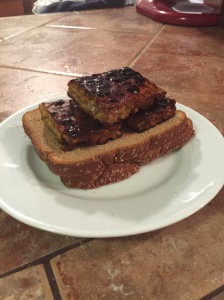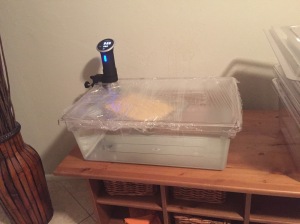After getting everything needed, I’ve taken the time to make a new food at home, tempeh!
[I’ll include a quick list of foods needed at the bottom if you want to skim through this]
It’s a fermented food originating from Indonesia. Describing what it is could throw some people off, I know. The thing to realize is, bacteria & different molds are in nearly every food we eat on a daily basis.
Tempeh is a food that can be made with soy beans, barley, and quite a few other media. That media is fermented, bound together by a natural culture, and forms a solid body. That body can be cut into various shapes depending upon needs. I’ve personally just cut a patty, cooked it as I would a hamburger patty with a little olive oil & balsamic vinegar. It has an earthy taste, with subtle nuttiness, and also takes on flavors of marinades to add to it. The reason for this for me is because soy beans have quite a few things in them that inhibit the human body from digesting the nutrients contained within. When you ferment, the process in a way pre-digests the bean contents, with an end result the human body can easily absorb. It’s also frickin awesome to experiment with new food types for me, especially when it’s scientific.
ON TO HOW TO DO IT!
To start, you’ll need to source a supply of tempeh culture & soybeans.
The tempeh culture could be either Rhizopus oligosporus or Rhizopus oryzae. For a first time, I went with Rhizopus oligosporus. My supplier is TempeStarter/IndoPal (www.tempestarter.com) based in Indonesia, and I’m in Arizona USA. I picked up a 120 gram package which was $16.95 + $8.95 shipping. The 1 teaspoon I used wasn’t alot, I’d say there’s about 15-20 teaspoons in there.
I have a sous vide circulator/cooker made by Anova that inserts into water, then runs a circulator along with heating the water to the temperature I program it with. This entire process can be modified however you wish.
- I used soy beans from Laura soy beans (http://www.laurasoybeans.com) that I buy to make soy milk due to my lactose intolerance. Non-GMO, and always great quality.
- I first took 2 cups of soy beans & soaked them for a day in water at room temperature.
- I then drained, and placed in fresh water.
- The hulls need to be removed, so I kneaded the beans (at times rubbing bunches of them between my hands) to brush the hulls off. This is what takes most of the time.
- I then washed the beans again, dumping the hulls out as they floated to the top. (I used my garbage disposal, but you can use whatever method)
- Then, put beans in pot, add water until beans are just covered, & add 4 teaspoons vinegar, bring water to a boil.
- Simmer for 35 minutes.
- Drain and remove the remaining boiled off hulls
- Put beans into large bowl, and using a hair dryer stir & blow dry the beans. Don’t skimp on this, dry them until they’re dry to the touch – the starter doesn’t do well with moisture on the outside of the beans at the beginning.
(This can be done with a dehydrator at about 115 as well)
- Add 1 teaspoon of starter/culture, sprinkling it throughout. Stir in VERY good through the entire body of beans.
- Add to 9×13 rectangular cooking pan (mine was glass), and spread evenly, patting down once done.
I used a 13-gallon cambro container filled with water, and inserted the sous vide circulator with it set to 88 degrees. (the image shows 90’s because tap water came out hot, it cooled and tempeh culture can handle up to 99-100 degrees)
Once the temp is stabilized, it’s ready. I placed the cooking pan like a boat into the water, verifying the water level on the outside of the pan was alright. I then placed plastic wrap over the top of the container to capture the heat in the air (for the top of the tempeh), then set a timer for 30 or so hours.
Once you pull the pan, put it into a pre-heated oven at 180 degrees for 30 minutes covered, which will stop the fermentation completely. Before putting it into the oven, you can place marinades into the pan. When the tempeh is warm, it absorbs the marinades much better.
For those that are wanting to know how to gauge how things are going, you probably won’t see anything for the first 10 hours. About then is when the activity starts happening, and heat is produced by the tempeh. (absorbed by the water)
You can pull the cooking pan anywhere from 24-48 hours, but my recommendation is to wait until between 30-36 hours. The second stage of fermentation starts at about 30 hours at 88 degrees, and produces a more fuller taste. I pulled mine at 32 hours, and it was awesome.

The above image is after I cooked the pieces in olive oil & balsamic vinegar. I added a few drops of Sriracha hot sauce to give it a little spiciness, as well.
Storage:
Tempeh will not last very long at room temperature, approximately 4-5 days at most. You can either refrigerate or freeze them.
QUICK LIST OF FOODS NEEDED:
- Tempeh starter/culture – http://www.tempehstarter.com
- Tempeh Starters (Rhizopus Oligosporus ) 120 Grams Cap Jago (there are others, you can choose yours, this is mine)
- Soy Beans – http://www.laurasoybeans.com
- Whatever package size you want, just be careful not to get sprouting/natto soy beans unless you’re doing something else. This needs regular soy beans.
EDIT:
After doing this I created a homemade tempeh incubator that is quite bulletproof, and I wrote an article on it. https://ampedup.wordpress.com/2015/08/02/tempeh-incubator/



Good stuff – exactly what I was looking for. Now I’ll check out your incubator post. Much obliged.